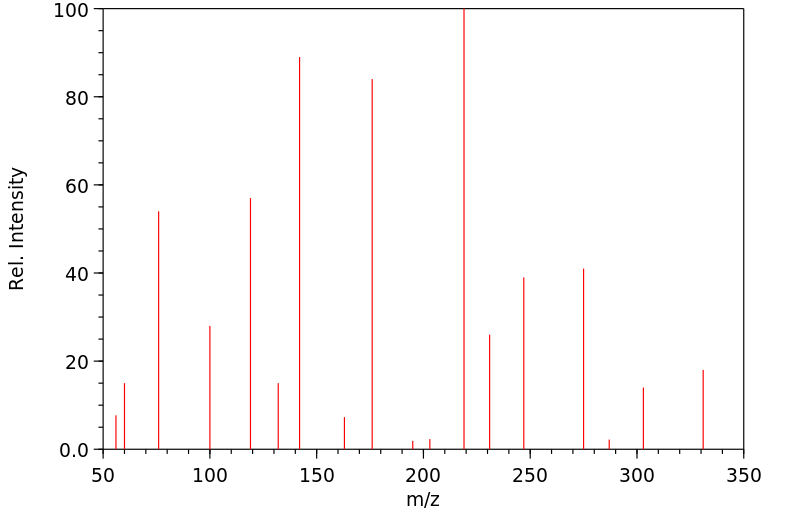N-[bis(dimethylamino)phosphanyl]-N-methylmethanamine;carbon monoxide;iron | 19372-47-5
中文名称
——
中文别名
——
英文名称
N-[bis(dimethylamino)phosphanyl]-N-methylmethanamine;carbon monoxide;iron
英文别名
——
CAS
19372-47-5;40697-04-9
化学式
C10H18FeN3O4P
mdl
——
分子量
331.091
InChiKey
RMGYLHZRPMPOPS-UHFFFAOYSA-N
BEILSTEIN
——
EINECS
——
-
物化性质
-
计算性质
-
ADMET
-
安全信息
-
SDS
-
制备方法与用途
-
上下游信息
-
文献信息
-
表征谱图
-
同类化合物
-
相关功能分类
-
相关结构分类
计算性质
-
辛醇/水分配系数(LogP):None
-
重原子数:None
-
可旋转键数:None
-
环数:None
-
sp3杂化的碳原子比例:None
-
拓扑面积:None
-
氢给体数:None
-
氢受体数:None
反应信息
-
作为反应物:参考文献:名称:First aminosilyl bridging ligand in a bimetallic complex: structure of [(OC)3{(Me2N)2(MeO)P}Fe{µ-Si(OMe)2(NMe2)}Cu(PPh3)]摘要:The first example of a bridging aminosilyl ligand between two transition metals is reported and the crystal structure of the bimetallic complex [(OC)(3){(Me(2)N)(2)(MeO)P}Fe{mu-Si(OMe)(2)(NMe(2))}Cu(PPh(3))] establishes the presence of an unprecedented four-membered cycle; selective metal-promoted OMe/NMe(2) substituent exchange between P and Si occurs-during the synthesis of the iron-silylene precursor.DOI:10.1039/cc9960002237
-
作为产物:描述:五羰基铁 、 三(二甲胺基)膦 以 neat (no solvent) 为溶剂, 生成 N-[bis(dimethylamino)phosphanyl]-N-methylmethanamine;carbon monoxide;iron参考文献:名称:Inoue, Hidenary; Nakagome, Takashi; Kuroiwa, Takeshi, Zeitschrift fur Naturforschung, B: Chemical Sciences, 1987, vol. 42, # 5, p. 573 - 578摘要:DOI:
文献信息
-
Gmelin Handbuch der Anorganischen Chemie, Gmelin Handbook: Fe: Org.Verb.B1, 1.1.4.4.3.1, page 148 - 168作者:DOI:——日期:——
-
Phosphorus-31-phosphorus-31 coupling in metal complexes containing two different phosphorus ligands作者:F. B. Ogilvie、R. L. Keiter、G. Wulfsberg、J. G. VerkadeDOI:10.1021/ic50081a024日期:1969.11
-
Cowley, Alan H.; Davis, Raymond E.; Remadna, Khier, Inorganic Chemistry, 1981, vol. 20, # 7, p. 2146 - 2152作者:Cowley, Alan H.、Davis, Raymond E.、Remadna, KhierDOI:——日期:——
-
Thiocarbonyl complexes of iron: formation of dinuclear compounds by the phosphine-induced CO-CS coupling in the reaction of Fe(CO)4CS with P(NMe2)3. Molecular structure of Fe2(CO)6S2COCP(NMe2)3作者:Wolfgang Petz、Frank WellerDOI:10.1021/om00034a044日期:1993.10Slow addition of Fe(CO)4CS to an excess of P(NMe2)3 affords the dinuclear complexes Fe2(CO)6S2COCP(NMe2)3 (1) and Fe2(CO)5(P(NMe2)3)S2COCP(NMe2)3 (2), the mononuclear complex (Fe(CO)2(P(NMe2)3)S2COCP(NMe2)3(3), and the sulfur transfer product S=P(NMe2)3 (4). The iron compounds contain a new betaine-like ligand which is composed of P(NMe2)3, CS, CO, and an additional S atom and bonded to the iron atoms via the sulfur atoms: C-C bond formation between the CS group and one CO ligand has occurred. Complex 1 crystallizes in the space group Pbca with cell parameters a = 1513.3(3) pm, b = 1324.3(1) pm, c = 2278.4(2) pm, and Z = 8. The dinuclear compounds 1 and 2 have a butterfly structure, and the ligand acts as a six-electron donor. P-31, C-13, and H-1 NMR and IR spectra are in accord with the structures.
表征谱图
-
氢谱1HNMR
-
质谱MS
-
碳谱13CNMR
-
红外IR
-
拉曼Raman
-
峰位数据
-
峰位匹配
-
表征信息
同类化合物
黄原酸环癸酯
高纯三甲基锑
顺式-二氯二(环丙胺)铂(II)
顺式-二氯二(乙二胺)氯化铑(1+)
顺式-二(环己基丁氨合)二氯铂(II)
顺式-二(异丙基氨合)二氯铂(II)
顺式-(2-氨基甲基-1-环戊基氨合)二氯铂(II)
顺二氯二羰基铂(II)
顺-二氯双(乙二胺)氯化铱
雷(酸)汞[含水或水加乙醇≥20]
间碳硼烷-9-硫醇
镍,加合(7:2)钪
镉二(二戊基二硫代氨基甲酸盐)
镁,溴-6-庚烯基-
manganese carbide
butyl manganese bromide
锡烷,氯二环己基-
锡四丁醇
锑,(1:1)混合物和钪
锌叔-丁氧化物
锌,溴-1-丙烯基-,(E)-
锇,加合(2:1)钪
锆酸四丁酯
锂丁酯
锂4-异丙氧基-2-甲基-丁烷-2-醇
锂1-丁醇
锂(三氟甲基)乙炔化物
锂(3-氨基丙基)酰胺
铼五羰基碘化物
铼五羰基
银(I)2-羟基乙烷-1-硫醇盐
铯三氯三羰基锇
铬三乙二胺
铬,五羰基(环己胺)-,(OC-6-22)-
铬,二(乙酰腈)二氯-
铝,加合(3:1)钪
铜-乙二胺络合物
铜(II)乙二胺
铜(I)乙炔化物
铍,环戊-1,3-二烯,溴化
铊N,N-二正丁胺
铊,甲氧基二甲基-
铂(2+)二氯化3-甲基丁烷-1,2-二胺(1:1)
铁(3+)三(1-丁醇)
铁(2+)1,1'-(硫烷二基二-1,1-乙二基)二-2,4-环戊二烯化
铀,三甲基-
钾,[三(三甲基甲硅烷基)甲基]-
钴四异硫氰酸酯
钴,乙烷-1,2-二胺
钠辛基二硫代氨基甲酸酯







